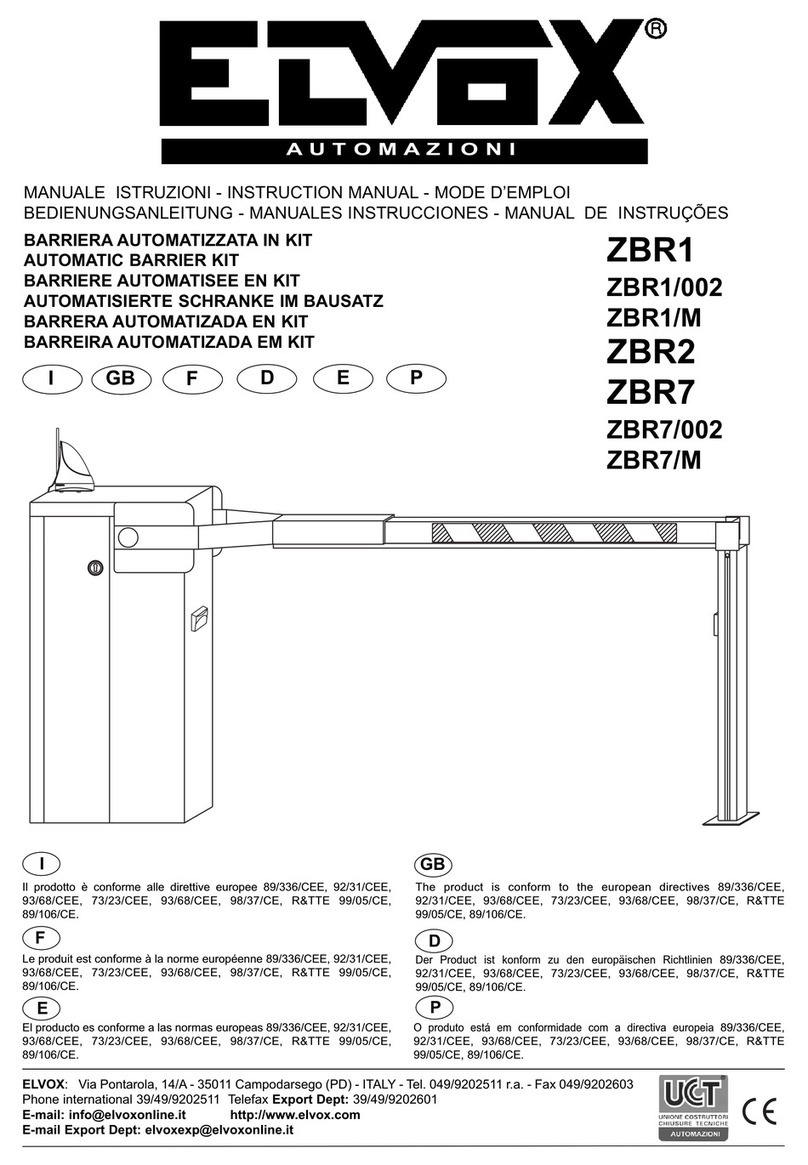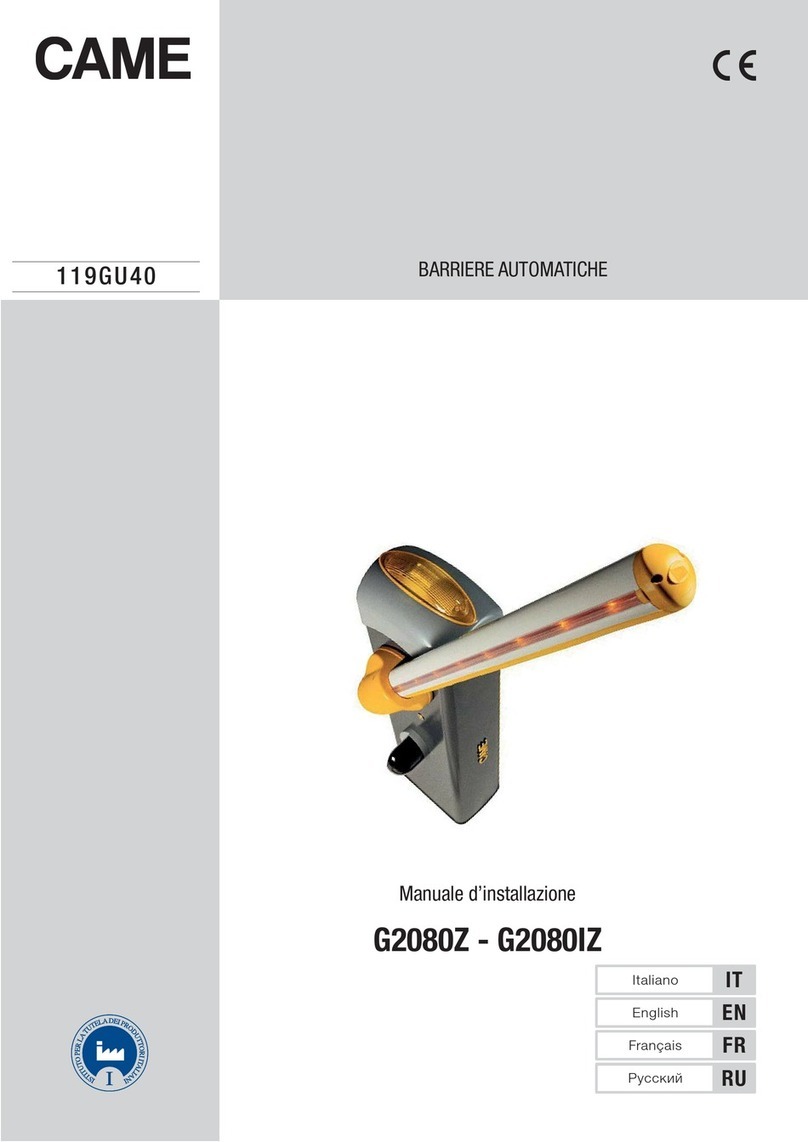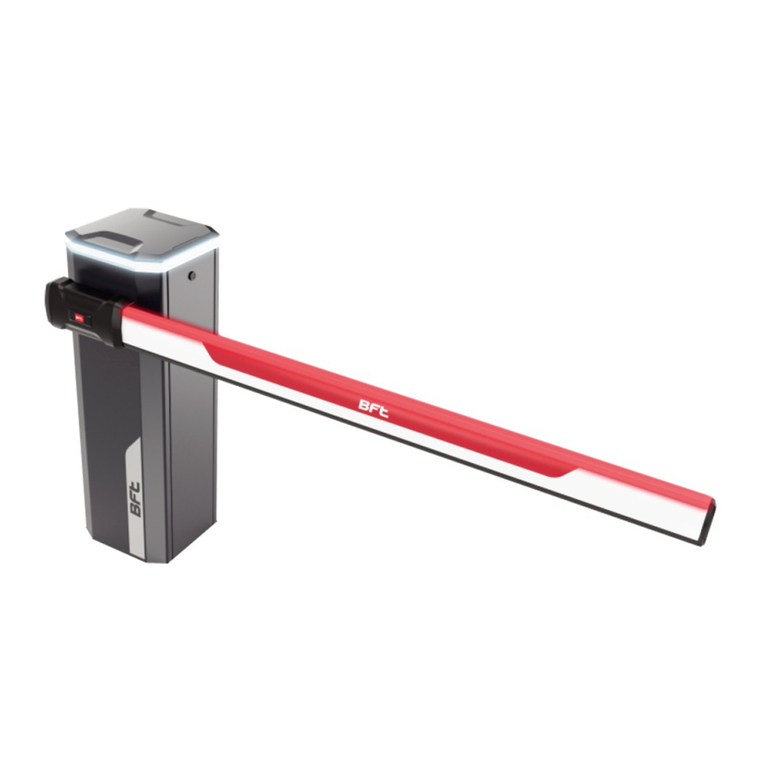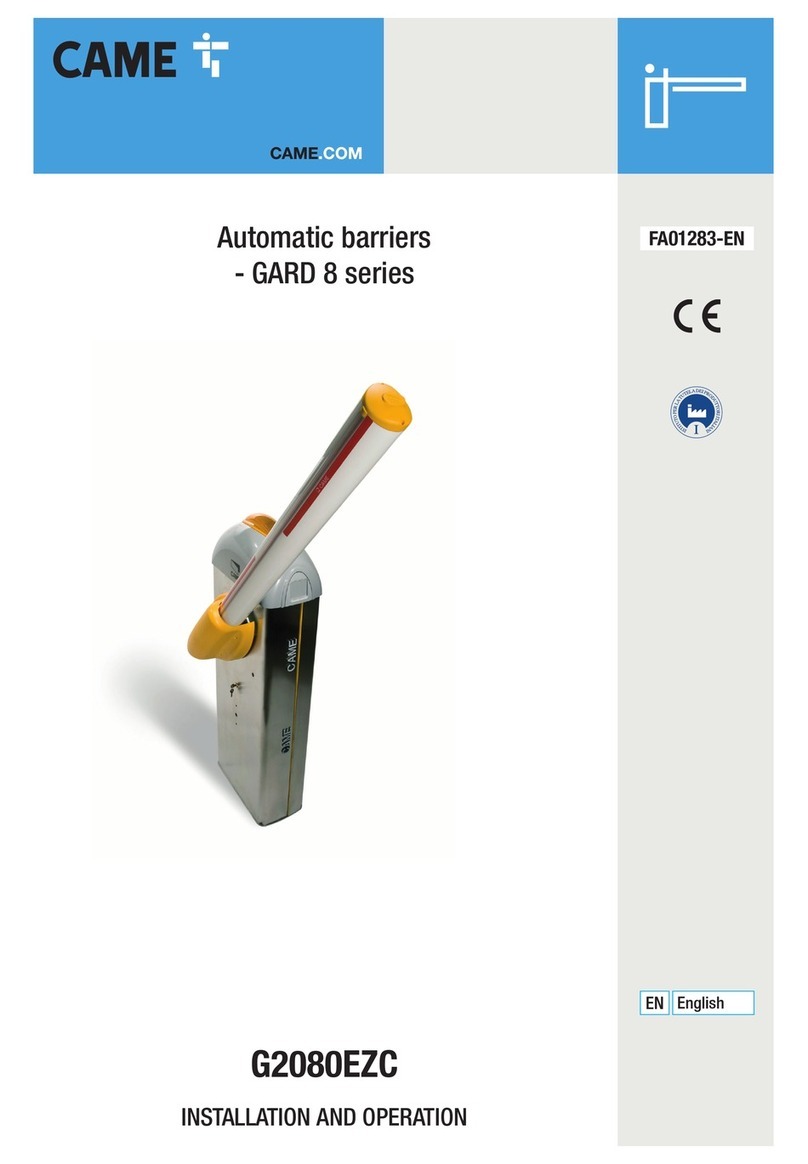MachPower AC-ASDSC-017 User manual

User Manual
AUTOMATIC SWING DOOR GATE
EN
Manuale d'uso
VARCO AUTOMATICO SWING DOOR
ITA
Manual de usuario
PUERTA AUTOMÁTICA BATIENTE
ES
AC-ASDSC-017

2

ENG
3
Index
Product introduction
Installation instruction
Debug method instruction
Menu introduction
Operation Instruction of System
Parameters Setup Turnstile wiring diagram
Electric Swing Barrier Communication Protocol
Wiring diagram
4
5
6
8
8
10
12

4
Product introduction
1. Function and characteristics
1.1 Functional features of standard product
1. With function of self-examine and alarm, it is convenient for maintenance and
use.
2. Being able to program operation status by the small keyboard in the main bo-
ard
3. Preventing pedestrians from being nipped and from hurt, the force of the pole
is less than 2Kg
4. Arms are automatically locked until opening signal is received.
5. Arms synchronization (adjustable)
6. Automatically reset function: It will automatically lock if the pedestrian hasn’t
pass through the channel in the pre-set time after the opening. The passing time
is adjustable.
7. Unit can be adjusted permanent open or close when power off to meet diffe-
rent requirement.
8. Several card readers are attachable, and relay signals can be received.
9. One direction or bi-direction are optional.
10. It can be directly controlled and managed by remote computer
11. Automatic prolong time reset, the default time is 10seconds
12. The swing barrier automatically opens after power off and automatically closes
when power on, which accords with fire-fighting
2. Standard technical parameters
Framework material GB 304 grade stainless steel
Passage Width 530mm (standard)
Dimensions of the structure 280 x 380 x 1000 mm
Diameter of main pillar 168mm
Arm’s running angle 180degree
Swing direction single or double
Working voltage AC220 ±10% V/50 ±10% HZ
Driving electromagnet DC electromagnet 24V

5
ENG
Input interface
Dry contact signal or +12V level signal
or pulse signal with width of more than
100ms DC12V, driving current: > 10mA
Communication interface RS485(standard)
Distance less than 1200metres
Transit speed 40 persons/min(open often),
25-30 persons/min(close often)
Time for opening or closing 2-3seconds
Starting time after power is on 3 seconds
Automatic reset time after fault 10 seconds
Working environment Indoor, outdoor( with a tent over)
Temperature -10°C ~ 50°C
Relative humidity ≤90% no condensation
Installation instruction
1. Installation on the ground
First of all, earthwork (a concrete base foot of 200mm height for anti-humidity)
(Hereinafter called Safe island) should be built. Then, power cable of 220V3*1.5mm
and two 4*0.5mm control cable should be laid under the middle of the casework.
Fix the mechanism on the safe island by 4 bolts according to the installation dia-
gram. Connect it with power of 220V and control cable should be linked to con-
trol room.

6
open housing by key, and connect cable and fix screw from here
Left protoelectric switch
Motor
Zero photoelectric switch Motor
Arm shaft
Right protoelectric switch
Brake shaft

7
ENG
2. Preparation before use
1. Input interface: +12V level signal or DC12V pulse signal with more than 100ms
pulse width, driving current>10mA or dry contact signal or RS485 signal;
2. Wiring connection: please connect the wires according to the marks
L/R Open Link Cable
OUT-
OUT+
GUI-R
GUI-L
OPE-R
OPE-L
GND
OPE-R
OPE-L
VDD
Note:
Methods of barrier open signal connection are provided as follow.
A. Dry contact signal: VDD is common port, OPE-L and OPE-R respectively linking
with VDD means a signal of left-open and right-open;
B. +12V level signal or DC12V pulse signal: GND is common port, OPE-L and
OPE-R connecting with GND respectively become a high electrical level loop and
a low electrical level loop. The form loop is left-open signal and the latter one is
right-open signal.(Note: High frequency should link OPE-L or OPE-R)
C. RS485 signal: TA, TB is A+, B- respectively, GND is common grounding.
D. Link cable: Directly connect the link cable ports of the two turnstiles(BUT1,
OPE-L, OPE-R, CLOSE-L, CLOSE-R, GND)
3. Check the cable linking, make sure it accords with the diagram and all the
interfaces have been firmly connected. Check that all the devices are earthing or
not, only everything is OK, can the mechanism be debugged
3. Important notices
1. Without permission, please do not install any devices on the casework. Make
sure the equipment’s earthing is reliable and devices are in the condition of safety
and reliability.
2. When the devices are used in the open air, they should be install on cement
podium of 100mm---200mm height so as to avoid moisture; at the same time,
build a tent over the devices to keep from rain. Directly installation in the open air

8
is strictly prohibited.
Debug method instruction
1. Preparation
1 copy of wiring diagram of swing barrier, 1 set of swing barrier device
2. Check the wire connection
Check the wire connection according to the wiring diagram, ensure that all
the wire connection is all right. Thereafter, debugging can be starting.
The device must be earthing well, otherwise, debugging is not allowed.
3. Function debug
1. The access gate is bi-directional swing barrier gate, which
going in or going out signal are acceptable.
2. The machine will alarm, if the pedestrian doesn’t read a card on the card
reader. (Two directions included)
3. When card reader receives a valid signal, direction indicator will show a
green arrow and meanwhile the swing barrier gate will unlock for a short time,
Whether the pedestrian has passed through gate or not, the barrier gate will
automatically close in the pre-set time.
4. The tail is also allowed to pass in the pre-set time for opening.
5. Swing barrier’s running speed is adjustable. Please refer to parameters setup
4. Power on
1. The swing barrier is normal mode,automatically close when power on and auto-
matically open when power off.
Operation Instruction of System
Parameters Setup
1. General description
1. Display refers to the three-digital LED on the main control panel.
2. From left to right, the three buttons are INC key, SET key, DEC key, SET key is
used in the Entry and Back menu or for the function setting of entry and

9
ENG
back; INC key is used to plus 1 at one time to the parameter needed setup; and
DEC key is used to minus 1 at a time to the parameter required setup
2. Entry and Exit Menu Setup
1. Enter menu
Press set key, after hearing a sound “du”, loosen from SET key. At this time, The
word “poo” is displayed, which means that it’s in status of menu setup. And at this
time INC key and DEC key can be choose to setup
2. Function number
Press INC key for function number plus one , and press DEC
key for function number minus one; there are 15 kinds of functions as below:
POO: Exit from menu setting, when POO appears, press SET Key to back.
PO1: The running direction when power on,=000 means forward rotating, and
• 001: means reversal reverse
P02: The longest time of barrier’s operation, its measurement is 0.1sec, so when
we set time 60, the time of barrier closing is 6 seconds. When the barrier has not
closed in 6 sec, it will automatically stop. (System default is 60)
P03: The passing time, measurement is second. Number 10 means 10 seconds,
turnstile close of pedestrian didn’t pass turnstile in 10S (System default is 10)
P04: Working mode (System default is 000) =000 bi-direction use(swipe card)
• 001: swipe card for entry but exit freely =002 swipe card for exit but entry freely
• 003: entry and exit are freely
• 004: entry only (single direction) =005 exit only (single direction)
P05: The speed of barrier gate opening for entry, system default is 10.
P06: The speed of barrier gate closing after entry, system default is 10.
P07: The speed of barrier gate opening for exit, system default is 10
P08: The speed of barrier gate close after exit, system default is 10.
P09: The pedestrians pass through the barrier gate in the pre-set time will be re-
garded as one person.(system default is 10)
P10: Entry counter reset: when P10 appear, press SET , it display C-L, press INC ,
entry counter reset
P11: Exit counter reset:, when P11 appear, press SET , it display C-R, press INC ,exit
counter reset.
P12: Memory function setup (system default is 000)
• 000: entry and exit with memory,
• 001: entry without memory,exit with memory
• 002: entry with memory,exit without memory
• 003: entry and exit without memory

10
P13: Equipment communication address, range from 1-255. (System default is 001)
P14: Equipment types
• 000: swing barrier =001: wing barrier(Flap barrier)
P15: System default reset , when P15 appear, press SET Key, it will display P-2, press
INC to reset system default.
P16: Normal open ,Normal close ,Normal mode , (System default is 000)
• 000: Normal close
• 001: Normal open
P17: Sensor delay function(customized function ,system default000)
•001: The gate delay 1s to close after people pass turnstile (maximam10s)
P18: Sensor anti-clamp delay function(customized function ,system default 000)
• 001: The gate delay 1s to close after people pass middle anti-pinch sensor (maxi-
mam10s)
P19: Motor setting (system default 000)
3. Back from menu setup
Press INC Key or DEC Key, when it display the word POO, press SET Key to back
from menu setup.
Electric Swing Barrier
Communication Protocol
1. Hardware Protocol
• Communication signal: RS485,
• Communication baud rate: 9600bps Start and end from one bit
• Data bits: 8 bits
• Parity check bit: No
2. Frame Rate Agreement
1. The frame format of upper computer: Synchronization code + equipment ad-
dress + command code + check code
Synchronization code: Receiving and sending message in hex 235 ( decimal sy-
stem)
Equipment address: Sending and receiving message in hex Equipment address

11
ENG
range from 0-255 (decimal system)
Command code/data
1. left barrier opening order 40H 00H
2.right barrier opening order 41H 00H
Check code
(synchronization code) XOR
(equipment address) XOR
(order)
E.g. equipment address is 1 interval order
Left barrier opening order, EB 01 40 00 AA
Right barrier opening order, EB 01 41 00 AB
3. Frame format of sending and receiving message of single core mechanism
Synchronization code + equipment address + data + check code
Synchronization code: Sending and receiving message in hex
Equipment address range from 0 to 255 ( decimal system)
a. For the order of readmen, data returned is two bytes, of which the first one is
upper-byte and the second one is lower-byte;
b. For the command order turning back to be QR Code QR Code of left barrier
opening order C0H 00H QR Code of right barrier opening order C1H 00H
Check code: (Synchronization code) XOR (Equipment address) XOR (Data 1) XOR
(Date 2)

12
Wiring Diagram
OUT1
AC IN
CON2
BUZZER
BUZZER
F1
F2
2A
3A
CON1
ALARM
OUT-
OUT+
GUI-R
GUI-L
OPE-R
OPE-L
GND
OPE-R
OPE-L
VDD
VDD
VDD
OPE-R
CNT-R
DIR-R
GND
GND-R
IN-R
VDD
BUT1
OPE-L
CNT-L
DIR-L
GND
GND-L
IN-L
+24V
ALARM
TA
TB
PA
PB
PC
PD
DX
MIX
SET
L10
L10
LE1
L1
L2
L3
L4
L5
L6
L7
L8
LE2 LE3
INCD EC
RX
CX
LX
PX
L/R Open Link Cable
POWER
TRANSFORMER
AIR SWITCH
ACCUMULATOR
MAIN PCB

13
ENG

14

15
ITA
15
Indice
Introduzione al prodotto
Istruzioni per l'installazione
Istruzioni sulla messa a punto
Istruzioni operative per l'impostazione dei parametri di sistema
Protocollo di comunicazione del varco elettrico
Schema elettrico
16
17
20
21
23
25

1616
Introduzione al prodotto
1. Funzioni e caratteristiche
1.1 Caratteristiche funzionali standard del prodotto
1. Funzione di auto-test e allarme, per una manutenzione e utilizzo facilitato.
2. Programmabile tramite una mini tastiera integrata nel pannello di controllo.
3. Funzione di blocco automatico dell'anta quando viene bloccata, impedendo
eventuali danni agli utenti, la forza del braccio è inferiore ai 2 kg.
4. Le ante vengono automaticamente bloccate fino alla ricezione del segnale di
apertura.
5. Sincronizzazione del varco (regolabile).
6. Funzione di ripristino automatico: bloccaggio automatico delle ante nel caso in
cui l’utente non sia riuscito a passare nel tempo prestabilito. Il tempo di passaggio
è regolabile.
7. Allo spegnimento il varco può essere impostato in modalità aperto o chiuso per
soddisfare requisiti diversi.
8. Compatibilità con diversi lettori di schede sono e possibilità di ricevere segnali a
relè.
9. La scelta ad un via o bidirezionale è opzionale.
10. Controllo e Gestione da remoto tramite computer.
11. Durata del reset automatico, il tempo predefinito è 10 secondi.
12. L’anta si apre automaticamente dopo lo spegnimento e si chiude automatica-
mente all'accensione, in accordo con le autorità locali.
2. Parametri tecnici standard
Materiale della struttura acciaio inossidabile GB 304
Dimensioni della struttura 280 x 380 x 1000 mm
Diametro della colonna 168mm
Larghezza del Passaggio 530mm (standard)
Angolo di apertura braccia 180 gradi
Direzione dell'oscillazione singola o doppia
Alimentazione AC220 ±10% V/50 ±10% HZ
Motore ad elettromagnete elettromagnete DC 24V

17
ITA
Interfaccia di ingresso
Contatto a secco o livello di segnale 12
V o segnale di impulso con larghezza
superiore a 100 ms DC12V, alimentazio-
ne motore:> 10mA
Interfaccia di comunicazione RS485 (standard)
Distanza inferiore a 1200 metri
Velocità di transito 40 persone / min (aperto spesso),
25-30 persone / min (chiuso spesso)
Tempo di apertura o chiusura 2-3 secondi
Tempo di avvio dopo l'accensione 3 secondi
Tempo di ripristino automatico dopo
guasto 10 secondi
Ambiente di lavoro interno, esterno (al coperto)
Temperatura -10°C ~ 50°C
Umidità relativa ≤90% senza condensa
Istruzioni per l'installazione
1. Fissaggio al pavimento
Prima di tutto deve essere effettuato un massetto di cemento di 200mm per pre-
venire l’umidità (chiamato “Safe Island”). Il cavo di alimentazione 220V 3x 1.5 mm e
i 2 cavi di controllo 4 x 0.5 mm ( 12 nuclei) devono essere posizionati al centro del-
la struttura. Fissare il meccanismo al massetto con 4 bulloni come descritto nello
schema di installazione. Collegarlo all’alimentazione da 220V e collegare i cavi di
controllo alla sala di controllo.

18
Aprire la struttura con la chiave, collegare il cavo e fissare la vite come mostrato.
Interruttore foto elettrico sinistro
Motore
Interruttore fotoelettrico principale Motore
Albero Braccio
Interruttore fotoelettrico destro
Albero freno

19
ITA
2. Preparazione prima dell’uso
1. Interfaccia di ingresso: livello di segnale 12 V o segnale di impulso DC12V con
larghezza superiore a 100 ms, alimentazione motore:> 10mA o segnale di contatto
a secco o segnale RS485;
2. Collegamento dei cavi: collegare i cavi secondo lo schema
S/D Aperto collegamento cavi
USCITA-
USCITA+
GUI-D
GUI-S
APERTO-D
APERTO-S
GND
APERTO-D
APERTO-S
VDD
Nota:
I metodi per la connessione del segnale di varco aperto sono i seguenti:
A. Segnale di contatto a secco: VDD è porta comune, APERTO-S e APERTO-D che
collegano rispettivamente con VDD : segnale di sinistra-aperta e di destra-aperta;
B. Segnale di livello + 12V o segnale di impulso DC12V: GND è porta comune,
APERTO-S e APERTO-D che si collegano con GND diventano rispettivamente un
circuito di livello elettrico elevato e un circuito di livello elettrico basso. Il circuito
crea un segnale aperto a sinistra per primo e un segnale aperto a destra per ulti-
mo (Nota: l'alta frequenza dovrebbe collegare APERTO-S o APERTO-R)
C. Segnale RS485: TA, TB è rispettivamente A +, B-, GND è la messa a terra comu-
ne.
D. Cavo di collegamento: collegare direttamente le porte del cavo di collegamen-
to dei due tornelliI (BUT1, APRIRE-S, APRIRE-D, CHIUDERE-S, CHIUDERE-D, GND)
3. Controllare il collegamento dei cavi, assicurarsi che siano collegati come da
schema e che tutte le interfacce siano state ben collegate. Verificare che tutti i
dispositivi abbiano la messa a terra, solo dopo questa verifica, è possibile eseguire
la messa a punto del dispositivo.

20
3. Informazioni Importanti
1. Non installare alcun dispositivo sul case. Assicurarsi che la messa a terra dei di-
spositivi sia sicura e che i dispositivi siano in condizioni di sicurezza e affidabilità.
2. In caso di utilizzo all’aperto dei dispositivi, assicurarsi che vengano installati su
un massetto di cemento da 100 mm / 200 mm per prevenire l’umidità; allo stes-
so tempo collocare i dispositivi al coperto (sotto una tenda) per evitare la pioggia.
L’installazione all’aperto è severamente vietata.
Istruzioni per la messa a punto
1. Preparazione
Una copia del disegno dello schema elettrico del varco, 1 varco
2. Controllare il cablaggio dei cavi
Controllare il cablaggio del cavo secondo lo schema elettrico, assicurarsi che tutto
il cablaggio del cavo sia corretto. Successivamente, può essere avviata la messa a
punto. Assicurarsi che il varco sia saldamente installato a terra, altrimenti la messa
a punto non partirà.
3. Funzioni
1. L’anta di accesso è una barriera a battente bidirezionale, con possibilità di entra-
ta e uscita.
2. Il varco emetterà un allarme, se l’utente non appoggia la carta sul lettore di
schede. (Due direzioni incluse)
3. Quando il lettore di schede riceve un segnale valido, l'indicatore di direzione
mostrerà una freccia verde e si aprirà il varco per un breve periodo. Indipenden-
temente dal fatto che l’utente abbia attraversato o meno il varco, il cancello della
barriera si chiuderà automaticamente nel tempo prestabilito.
4. L’estremità può passare nel tempo prestabilito dell’apertura.
5. La velocità di apertura dell’anta è regolabile. Fare riferimento alla configurazio-
ne dei parametri
4. Accensione
1. Il dispositivo è in modalità normale, si chiude automaticamente all'accensione e
si apre automaticamente allo spegnimento.
Table of contents
Languages:
Popular Automatic Barrier manuals by other brands

RIB
RIB STOPPER T 275 SA manual

Aprimatic
Aprimatic Harrier E25 Installation, use and maintenance instructions

BFT
BFT MOOVI 30 Installation and user manual
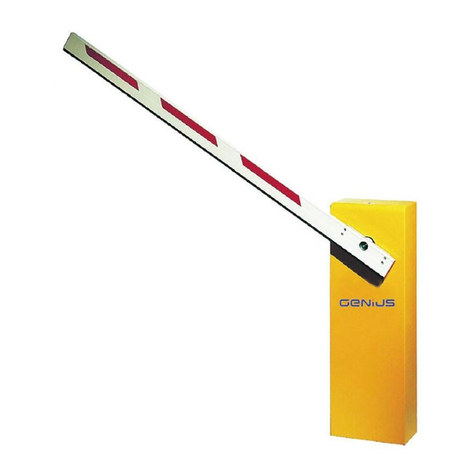
Genius
Genius SPIN Series GUIDE FOR THE INSTALLER
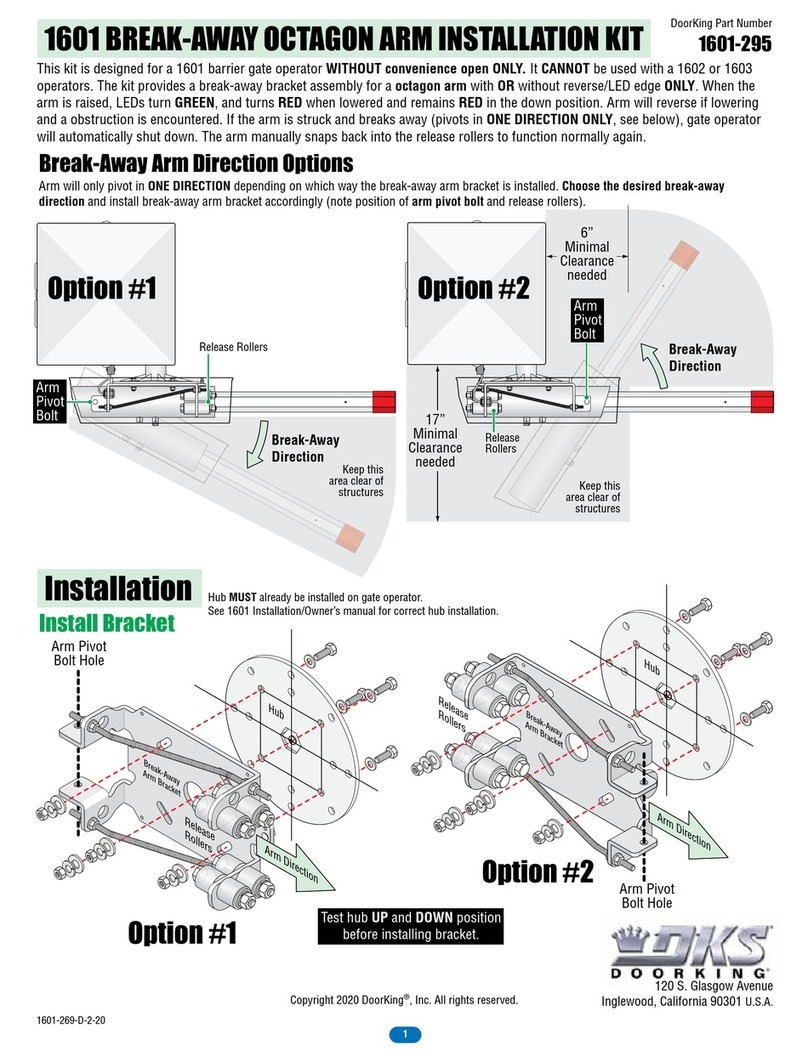
DoorKing
DoorKing 1601-295 owner's manual

Roger
Roger ALED Series Instruction and warnings for the installer
